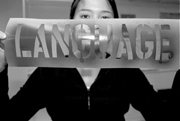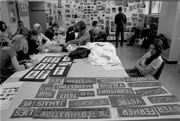
Kim Nguyen (University of Minnesota) in the “We Interrupt the Program”
atelier.

Karine Savard with other atelier participants reflect on the organization
of T-shirts, stencils, posters, and images for a Web site during 18
hours of production which, along with the work of two other ateliers
culminated in an exhibition in the VAV Gallery which opened the Declarations
Symposium.
Photos by Chris Heldt
|
by James Martin
Commuters may have recently noticed a fresh blip in their daily information
barrage. A simple sticker, plastered over the scrolling “info-screens”
in several Metro trains, obscured the usual lite-brite parade of newsbites
and celebrity gossip.
The innocuous typeface concealed a pointed question: Qu’est-ce qu’ils
nous racontent? The query could stand as an informal slogan for Declarations
of [inter]dependence and the im[media]cy of design, a symposium held by
Concordia’s Design Art Department late last month.
The first of its kind in Canada, Declarations looked at the ways in which
graphic designers are becoming increasingly socially and culturally engaged
through their work.
“Particularly in graphic design, a lot of what designers do is help
advertisers communicate messages, and much of that messaging is about
selling products,” says Associate Professor Michael Longford, who
put together the conference along with Dr. Lydia Sharman, PK Langshaw
and Rhona Richman Kenneally.
Declarations explored socially engaged approaches to working within the
design profession, as well as the idea of the designer actually authoring
messages born of personal belief, rather than commercial need. The wide
range of speakers included former Adbusters art director Chris Dixon,
Jean-Pierre Boyer and Jean Desjardins from UQAM (showcasing images from
an ambitious new CD-ROM archive of Quebec agitprop), and Patricia Zimmerman,
from Ithaca College in New York.
Some guests, like French activist-designer Brian Holmes, spoke of literally
taking their designs (in the forms of protest banners, posters, etc.)
to the streets. Others, like Amy Franceschini of Futurefarmers (a San
Francisco design firm set on “cultivating your conscience”),
talked about using initiatives such as student internships to help the
workplace better reflect one’s political-social beliefs.
“Many designers are looking
to establish a dialogue,” says Longford, “so it’s not a
one-way system where the client says ‘I need this’ and the designer
says ‘OK, I’ll give you that.’ Designers are in a position
to influence the kinds of messages we see and here.”
Students in both the Design Art Department’s undergraduate and new
graduate certificate programs, along with visiting students from Leeds
College and the University of Minnesota, put this theory into practice
during the symposium’s ateliers.
The approximately 70 students were divided into three groups: “Who
Needs a Manifesto?: WD + RU Speaks Out,” “Design Is Not Enough,”
and “We Interrupt The Program.” The four-day workshops were
intense, whirlwind affairs. Students first met on the Monday morning;
by Thursday evening, their collaborative works were on exhibit in the
VAV Gallery.
Teal Triggs and Siân Cook, of the Women’s Design + Research
Unit in the UK, guided students through the “Who Needs A [Man]ifesto?”
workshop, helping them write focused social-political statements, then
pairing their manifestos to appropriate graphic forms.
Anne-Marie Beaudoin and Jule Senzig, both second-year Design Art students,
were inspired by the process of transforming personal views into public
work.
“It really felt like I was putting myself on the line,” says
Beaudoin, “exposing what I truly felt. What’s personal and what’s
public — those two things play with each other. Whether you like
to believe that you’re not affected by what’s out there, you
are. The atelier confronted that at a truly deep level.”
Tony Credland, Brian Holmes and Sandy Kaltenborn, facilitators of the
“Design Is Not Enough” workshop, work with various international
activist groups to distribute socially-engaged images. Not surprisingly,
their atelier focused on non-aggressive street-level activity.
Students addressed community issues by creating and distributing, among
many items, mock humanitarian aid drop-boxes (complete with blindfolds
reading “It’s Going To Be OK”) and parodies of tear-a-tag
“for sale” posters — but instead of offering a phone number,
the tags posed questions such as “Is there a solution?” and
“Where does Evil take a bath?” (Design Is Not Enough was also
responsible for the aforementioned example of Metro culture-jamming.)
“The atelier has given me a great way to merge energies and ideas,
and a sense of collaboration instead of just being a designer making things
at my little desk,” said Laurel Sprengelmeyer, a design certificate
student.
Collaboration was also crucial to “We Interrupt The Program,”
facilitated by Ian Noble and Russell Bestley of the London College of
Printing. Students were asked to bring photos of subjects (people, environments
and objects) with personal resonance. The images were then posted on walls
as a way to kickstart a dialogue among the participants, exploring the
idea of graphic design as a democratic medium in which everyone is invested
in the message.
Chris Heldt, a fourth-year design student, says the atelier was a lesson
in the value of community, not only in terms of working with others on
the project, but in giving him “a really strong sense of community
in design, on an international scale.
“Now I know where to apply my energies, without wasting my time trying
to get a job at some square ad agency, doing slick flyers and pamphlets
for corporate identity.”
Like so many of the other atelier participants, Kevin Lo is excited to
do “the work that I want to be doing” — and it’s a
lesson learned the hard way. A Concordia Design Art alumnus, Lo spent
an unsatisfying year working at a Toronto Web design agency before enrolling
in the graduate certificate program.
“I came back to school at just the right time,” he says, laughing
at the memory of his ill-fated foray into the marketplace. “I was
really starting to lose faith in my abilities to do anything other than
cutting and pasting!”
|
|
|



